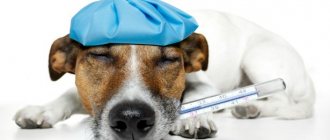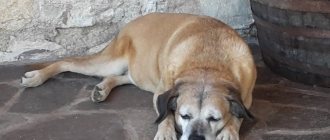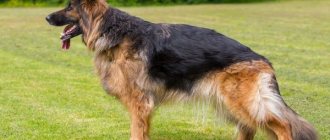Asthma in dogs is a serious pathology that affects the respiratory system. Its symptoms appear only during the period of exacerbation, turning out to be a real surprise for the owner. To save an animal, it is necessary to seek help as soon as possible in order to prevent its death from lack of oxygen.
Do dogs have asthma, and what is it?
Most often, asthma in dogs is bronchial. It develops due to hypersensitivity to certain irritants or as a complication of another disease.
The body of asthmatic animals produces protective mucus that settles on the bronchi. Over time, the viscous liquid that accumulates on the mucous membranes causes inflammation. The bronchi increase in size, blocking access to oxygen.
In parallel, pulmonary emphysema develops - a pathological expansion of the respiratory organs with loss of their elasticity. Ultimately, the dog experiences bronchospasm, accompanied by attacks of suffocation.
Causes of the disease
Depending on the cause, bronchial asthma in dogs can be congenital or acquired. In the first case, bad genes of the parents or a breed tendency are to blame for the disease, and in the second, external factors, diseases and infections.
External factors
Incorrectly selected physical activity can cause serious problems with the respiratory system. Most often, this cause is diagnosed in small breed dogs and puppies.
Keeping pets in cold rooms or in drafts contributes to the development of colds. In this case, bronchospasm develops as a complication.
Don't forget about stress. Emotional stress activates defense mechanisms, causing the body to produce increased amounts of hormones. Because of this, the dog’s heart rate increases and hypoxia develops.
A sharp change in climate associated with moving to another city or country is difficult not only for people, but also for animals. Unusual temperature and humidity, as well as pressure surges can lead to quite serious consequences.
Diseases and infections
The most common cause of asthma in dogs is allergies. It is caused by house dust, tobacco smoke, pollen, household chemicals and many other allergens. All these substances irritate the bronchi, causing swelling of their mucosa.
Excessive mucus production is caused by fungi, bacteria and viruses - pathogens of infectious diseases. Narrowing of the lumen in the respiratory tract is one of the complications of chronic bronchitis.
Breed or genetic predisposition
Those at risk include poodles, dachshunds, Maltese dogs, Jack Russell terriers, pugs, German shepherds and Labradors. As in humans, pathology is inherited. To do this, it is enough to have at least one asthmatic in the family, since the disease can manifest itself in puppies after several generations.
Preventive actions
It is almost impossible to predict the development of asthma in an animal before the first symptoms appear. If a spontaneous cough appears (especially in the morning or evening), it is advisable to thoroughly examine the pet in order to have the necessary medications to stop the acute attack. Preventive measures that can be taken if the animal is at risk:
- Improving living conditions - eliminating all chemicals, air fresheners, daily wet cleaning.
- During the repair work, keep your pet with relatives or friends.
- Ventilate the room.
- Pet weight control.
- Timely detection and treatment of chronic pathologies.
- Do not overload your pet with excessive physical activity.
- When keeping animals with confirmed asthma, it makes sense to purchase devices such as a washer or a humidifier. It is important to use devices according to the instructions and respect the area of the room in which they can function efficiently.
Bronchial asthma in dogs is not that common. It is important to identify the first signs of the disease in a timely manner so as not to start the process. Otherwise, irreversible processes develop in the respiratory system that reduce the quality and life expectancy of the animal.
Symptoms by type
Signs of asthma in dogs depend on the type of asthma. In addition to inflammation in the bronchi, the animal may suffer from pathology of the left ventricle, accompanied by insufficient blood pumping. Due to loss of elasticity, the contractile function of the heart is impaired. Over time, lack of blood leads to problems with the respiratory system.
Bronchial type
Treatments and symptoms of asthma in dogs are closely related. The condition worsens progressively, which requires a different set of medications for each stage.
At the very beginning, owners note a loss of usual activity and poor appetite. Over time, the lack of oxygen becomes more noticeable, so the symptoms are replenished with more obvious signs:
- whistling sound when breathing;
- the appearance of wheezing and a lingering dry cough;
- rhythmic breathing accompanied by abdominal muscle cramps;
- panic attack (the pet is overly intrusive or, conversely, avoids contact);
- involuntary urination while trying to catch your breath;
- adopting a hunched posture with widely spaced paws;
- blue mucous membranes.
If the cause of the disease lies in allergies, then the condition is complicated by sneezing, runny nose and increased tearfulness. The time before the attack occurs varies from person to person. It can last for several days or take only a couple of hours. For this reason, it is necessary to contact a veterinary clinic as soon as possible after detecting at least one of the listed signs.
Heart type
The symptoms of cardiac asthma in dogs are very different. This type of pathology is not associated with allergens, so classic allergy symptoms are not observed. Breathing is irregular and has no rhythm. Instead of blue, the mucous membranes have a pronounced gray-marble pattern and unnatural pallor.
Unlike inflammation in the bronchi, which appears at any time of the day, heart problems make themselves felt in the middle of the night. The disease is treated with diuretic therapy and complete exclusion of foods containing salt.
Stages of development of the disease
Asthma in dogs develops in stages with a gradual increase in alarming symptoms. The development of the disease includes 3 stages:
- Early
. The animal falls into apathy, moves little and eats poorly. Breathing is complicated by panting, shortness of breath and gurgling. Due to severe coughing attacks, the urinary canal involuntarily splashes out the contents. There is sneezing and discharge of clear fluid from the nose.
- height
. The most dangerous stage, fraught with suffocation. Due to lack of oxygen, the pet tries to catch a breath of air with its open mouth, spreading its paws wide and stretching its neck. His chest tenses, pulling the skin between his ribs. A dry cough periodically changes to a wet one. The heartbeat quickens and the mucous membranes turn blue. At the peak of the stage, the dog may lose consciousness, falling on its side or stomach.
- Reverse current
. If an attack of suffocation does not occur, then the development of the pathology freezes at one of the signs preceding it and rolls back. Alarming symptoms disappear. It becomes easier for the animal to breathe, but the weakness that sets in continues for several more days.
A mild form of the course is typical for animals at the age of 1 year, and an exacerbation of the disease is noted at 4-5 years. If the pathology becomes chronic, then coughing attacks become sporadic and not prolonged. Most often they bother you in the morning or evening.
Signs and symptoms of the disease
The characteristic symptoms of the disease in four-legged pets will not go unnoticed by the owner. The clinical picture of the pathology develops in stages. In the pathogenesis of bronchial asthma, the stage of precursors, the height of the attack and the reverse course of the pathology are distinguished. The precursor stage is characterized by the following symptoms:
- Change in breathing pattern. The dog begins to puff and breathe with his mouth open. Whistling when breathing is a characteristic symptom of the initial phase of a bronchial attack. Exhalation is easy for the dog, but tension is observed when inhaling. Inhalation often becomes convulsive and heavy.
- Dry, strained cough with whistling.
- Transparent and viscous discharge from the nasal cavity. There is often discharge from the eyes.
- Frequent sneezing.
- Itching in the eyes and nose. The dog scratches the irritated area with its paws.
- A sick pet will experience wheezing and gurgling sounds when breathing.
- The animal avoids active physical activity and does not take part in games. Walking is difficult for your pet.
- Appetite is reduced. Thirst is increased.
The most severe and dangerous phase of the disease is the height of a bronchial attack. At this stage the following clinical picture is observed:
- The animal takes a sitting position or stands with its front legs spread wide and its neck extended. The back is hunched, the ribs are straightened. The skin in the chest area is stretched.
This forced position is due to the fact that the body tries to compensate for oxygen starvation by increasing the volume of the chest.
- Breathing becomes heavy and intermittent. The inhalation is short, with whistling and wheezing. Exhale slowly. When breathing, there are convulsive movements in the abdominal area. The owner notices heavy breathing at a distance from the pet. The wings of the nose are widened and moist.
- Abdominal spasms often lead to involuntary urination.
- The mucous membranes become blue, which indicates the development of hypoxia and is a life-threatening symptom for the animal.
The reverse stage of asthma is characterized by attenuation of characteristic clinical signs. The animal remains lethargic, apathetic, and weak for a long time. No appetite.
Examination at the veterinary clinic
Before you understand how to treat asthma in a dog, you need to make sure it is present. Many other diseases of the respiratory system have similar symptoms, so all possible studies are used to make a diagnosis:
- PCR blood test necessary to identify the causative agent of infection;
- auscultation, assessing lung functionality;
- chest x-ray revealing pathological changes;
- bronchoscopy demonstrating the extent of inflammation and swelling;
- bronchoalveolar lavage, which allows you to study washings from the bronchi.
The cause of the disease cannot always be found. It is especially difficult to identify allergens, which precludes their complete elimination. The owners can only strictly follow medical recommendations and try to reduce the likelihood of new attacks through prevention.
Treatment of the disease
Therapeutic measures have a positive result, as a rule, in the case of identifying and eliminating the true cause of the disease. After the attack is relieved, the animal is prescribed corticosteroid drugs, for example, Hydrocartisone and its analogues. A course of Prednisolone has a good therapeutic effect.
Much attention should be paid to strengthening local and general immunity. For this purpose, the dog is given a course of immunomodulatory drugs - Anandin, Fosprinil, Roncoleukin, Gamavit. Vitamin therapy helps improve the condition of the bronchial mucosa and the processes of regeneration of alveolar tissue. Dogs with asthma are prescribed injections of vitamin B1, A, and ascorbic acid.
For information on the causes, symptoms and treatment of asthma in dogs, watch this video:
Treatment and host actions
In most cases, asthma attacks in dogs can be managed with supportive care for the rest of their lives. Full recovery is possible only for those pets whose cause of the disease has been diagnosed.
First aid for an attack of suffocation
First of all, owners should remember how to act during an attack of suffocation in a dog if asthma is at its peak. To remove it, use oxygen masks or special spacers with a therapeutic aerosol.
After the examination, the animal is gradually taught to breathe through a mask, encouraging it with treats. To normalize breathing, it is enough to take only 7-10 breaths.
During the next attack, you need to place your pet in a comfortable and safe place. After this, let him breathe through the mask and inject an antispasmodic (No-shpa, Papaverine) to suppress the spasms that arise.
Maintenance therapy
After stabilizing the four-legged patient’s condition, it is necessary to eliminate the cause of his illness. When an infection or allergy is detected, antibiotics, antivirals and antihistamines are used. To facilitate breathing and eliminate bronchospasm, bronchodilators are prescribed.
If the cause of a dog’s asthma attacks remains unknown, then it is treated with glucocorticosteroids. Taking these drugs suppresses the immune system's overreaction, preventing new attacks from occurring. The medicine is available in the form of injections, tablets and solutions for inhalation.
When the alarming symptoms disappear, the dose is gradually reduced, bringing it to a level that is safe for the body. Relapses are eliminated in the reverse way, that is, the dosage of the drug is again gradually increased until the condition stabilizes.
Veterinarians recommend marking the days you take the medication on a special calendar to track the frequency of attacks.
Four-legged care
It is recommended to protect your asthmatic pet from major allergens. Do not smoke in his presence, use environmentally friendly products to clean floors, and avoid walking near vegetation during the flowering period.
If your pet lives on the street, take him into the house. A warm room, protected from drafts and cold, will protect him from colds.
How to relieve an asthma attack in a pet?
Treatment of pathology at home is carried out only after a complete examination of the pet by a doctor.
If symptoms are noticed in an animal for the first time, the dog is given the most calm environment possible. It is necessary to avoid sudden movements and rough fixation. Self-administration of any medications is contraindicated and may aggravate the course of the pathology. Even if the attack has passed, a doctor is called to the house, or the pet is taken to a veterinary clinic for further examination.
After prescribed treatment for asthma, the dog owner should always have medications to relieve an acute attack. If medications are prescribed in inhalation form, the pet is accustomed to the mask in advance and gradually. After each procedure, the animal must be rewarded.
Animals use a spacer - this is a special device for inhaling medications in the form of a spray or aerosol. It consists of a small chamber, to one end of which a can of medicine is attached, and on the opposite side is connected a mask into which the pet’s muzzle will fit. During the procedure, the required amount of the drug is injected into the chambers and the animal is allowed to take 7-10 breaths.










